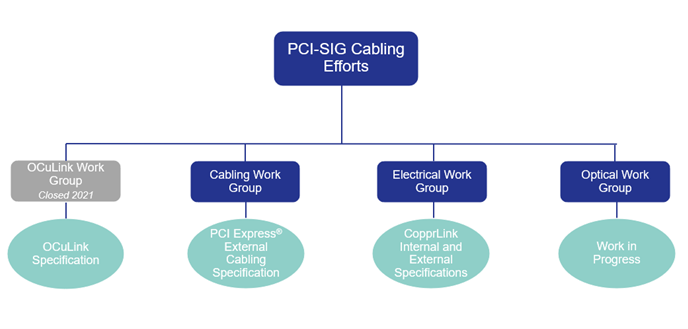PCIe® Cabling – The Journey to CopprLink™

As the application space for PCI Express® (PCIe®) cabling has grown, PCI-SIG® has kept up the pace to meet industry needs for high-speed cabling solutions. In this blog, we answer some common questions about PCIe cabling and the recently released CopprLink™ cables.
What is the history of PCI-SIG cabling?
PCI-SIG began its cabling initiatives in 2003 with the launch of the Cabling Work Group, aimed at defining the requirements for an external cable assembly and associated connectors to promote the scalability of PCIe links at 2.5 GT/s. The Cabling Work Group continues to develop specifications as a companion to the PCI Express Base Specification. In 2015, the OCuLink Workgroup was created with the goal of standardizing PCIe platform architectures on a common form factor to support internal and external PCIe cabled connections for 2.5, 5.0, and 8.0 GT/s. Following its initial publication, the OCuLink Work Group faced significant challenges to keep pace with the PCIe Express Base Specification and match new platform demands. The OCuLink Work Group closed in 2021, though PCI-SIG members can still view the OCuLink specification and there are OCuLink solutions still available in the market today. Also in 2021, the PCI-SIG recognized the importance of developing an updated standard for cabling solutions better aligned with the evolving needs of the industry for PCIe 5.0 and 6.0 technology and beyond.
What is the status of PCI-SIG cabling efforts?
PCI-SIG is addressing the industry’s cabling needs from multiple fronts. Mirroring the “pick your speeds and feeds” philosophy, PCI-SIG is ensuring the industry can choose the best PCIe technology solution for their application.
There are PCI-SIG cabling efforts within three different work groups: The Electrical Work Group (EWG), Cabling Work Group (CWG) and Optical Work Group (OWG). First, we will cover the recently released CopprLink Cable Internal and External specifications.
In 2021, PCI-SIG formed a sub-work group within the EWG to integrate cabling seamlessly within the PCIe electrical base specification while providing a path for future versions to enable next-generation applications beyond storage
The group developed the CopprLink™ Internal and External Cable specifications for PCIe 5.0 and 6.0 technology, which provide signaling at 32.0 and 64.0 GT/s respectively and leverages industry standard form factor connectors maintained by SNIA. Utilizing existing, well-established connector form factors speeds up adoption, time to market and reduces cost.
CopprLink cables will evolve with the same form factors for future bandwidth generations and bring PCIe cabling into the future. Many next-generation, latency-sensitive applications will benefit from PCIe CopprLink cables, including data center servers, storage, networking, accelerators and more.
What are the CopprLink Internal and External cable features and what are their target applications?
The CopprLink Internal and External cables include different connector form factors, reach and various target applications.
The CopprLink Internal cables utilize the SNIA SFF-TA-1016 connector, which is an Internal Unshielded High Speed Connector System. The Internal cable has a maximum reach of 1m within a single system. The Internal cable example implementations include motherboard-to-add-in-card, motherboard-to-backplane, chip-to-chip and add-in-card-to-backplane inside a self-contained server platform node. The Internal cables are targeted for storage and data center compute nodes.
The CopprLink External cables utilize the SNIA SFF-TA-1032 connector, which is a Multi-lane External High Speed Cable System. The External cable has a maximum reach of up to 2m. The External cable example implementations include CPU-to-storage, CPU-to-memory, CPU-to-accelerator, and accelerator fabrics in devices disaggregated server platform nodes. The External cables are targeted for storage and data center AI/ML where a longer reach is needed.
Will the CopprLink cables support future generations of PCIe technology?
Yes, the CopprLink Cables are intended to scale to future generations. The evolution of PCIe cabling to the CopprLink Internal and External cables allows PCIe technology to stay on the cutting edge of the market demand. The Electrical Work Group has already begun pathfinding work on CopprLink Cables for PCIe 7.0 architecture at 128.0 GT/s, highlighting PCI-SIG’s commitment to the CopprLink Cable specifications.
Are the CopprLink Cables related to the Optical PCIe interconnect the PCI-SIG is developing?
The Internal and External CopprLink Cables are not directly related to the Optical PCIe interconnect the PCI-SIG Optical Work Group is developing. PCI-SIG expects CopprLink Cables and the optical efforts to be complementary.
Optical PCIe is in the exploratory phase. PCIe optical support is intended to be technology-agnostic and support a wide range of optical technologies. PCI-SIG is also considering developing optical-specific form factor(s). Possible form factors include pluggable optical transceivers, on-board optics, co-packaged optics, and optical I/O.
Are there other cabling solutions that PCI-SIG is developing?
Yes, PCI-SIG’s Cabling WG is developing a new external cabling specification, based on the well-established SNIA SFF-8614 connector form factor, more commonly known as “MiniSAS-HD” for its typical use in storage applications. This effort is separate from the CopprLink cables and the Optical WG initiatives and targets an alternative storage solution to Serial Attached SCSI (SAS) or Serial Advanced Technology Attachment (SATA) protocols. The completion of the 5.0 External Cabling Specification achieves support for three successive generations of PCIe data rates (8.0, 16.0, and 32.0 GTs/s) and positions the PCIe technology as the fastest option among remote storage alternatives in the Enterprise market.
Why are there multiple cabling initiatives?
The various PCI-SIG cabling initiatives complement each other and offer specific benefits for different applications. For a birds-eye view of all PCIe cabling efforts, see the following table.
PCI-SIG Cabling Initiatives

How can I stay up to date on the latest PCI-SIG cabling developments?
We will host multiple sessions at the June PCI-SIG U.S. Developers Conference covering electrical, cabling and optical updates. PCI-SIG members can register for the event on our website.
To become involved in PCIe cabling development, we invite PCI-SIG members to join the Electrical, Cabling or Optical workgroups. More information about joining PCI-SIG and the member benefits is available on our website.
